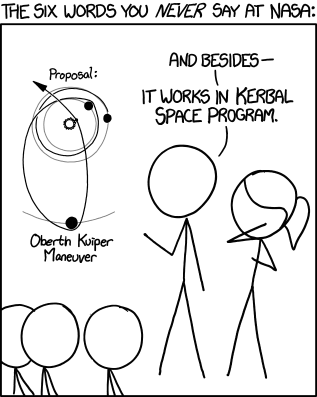Stable Orbits
In Kerbal
KSP uses conic approximations to calculate trajectories around
planets, moons and the sun. By focusing on only two bodies, a
computer can easily simulate gravitational forces between two
bodies and map the trajectories. This is done by ignoring
other sources of gravity when outside of a defined sphere of
influence. In practice, this allows one to easily calculate when would be ideal to launch a spacecraft from one planet and have it reach another planet. The angle required between the radii of the two planets is given by
Here, γ is defined by values of v, ω and t, where v is the departure and arrival angles reference the plane about the prevailing body (such as the sun), ω is the angular velocity at the final location (normally the angular velocity of a planet or moon) and t is starting and ending times of the orbit.
Reality

Munroe, Randall. Six Words. Digital image. Xkcd.com. N.p., 29 July 2013. Web. 22 Nov. 2014.
Reality however is not so simple. The universe does not
actually operate on spheres of influence, and there is a
reason that the method is called patched conic approximations.
For situations with more than two bodies, such as placing a
satellite in orbit between the moon and Earth, n-body
calculations are instead needed.
One important consequence of n-body calculations that is
not observed in conic approximations are Lagrange points.
Lagrange points are areas where the forces of gravity of two
bodies produces the proper forces to allow an object to
orbit that point. These points are located at the peaks and
troughs of the graph of the potential energy surface of the
two bodies. These points are places where the net
gravitational force is zero.

A spacecraft can be made to orbit these points with a little bit of corrective action, since they are not stable orbits. Using these points, satellites and probes can be sent to unusual orbits for data collection and then be brought back to Earth with relative ease, as was done in the Genesis discovery mission. They are also useful for making fuel saving maneuvers, such as MUSES-A when MUSES-B failed its mission.